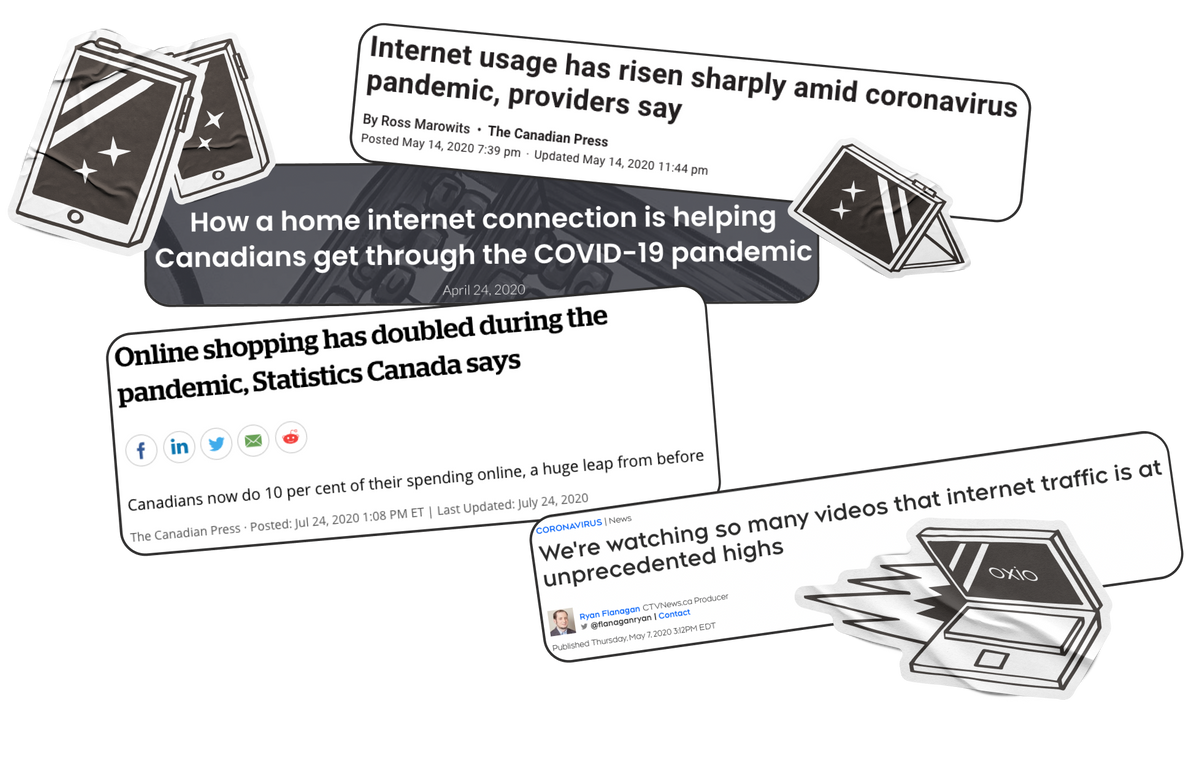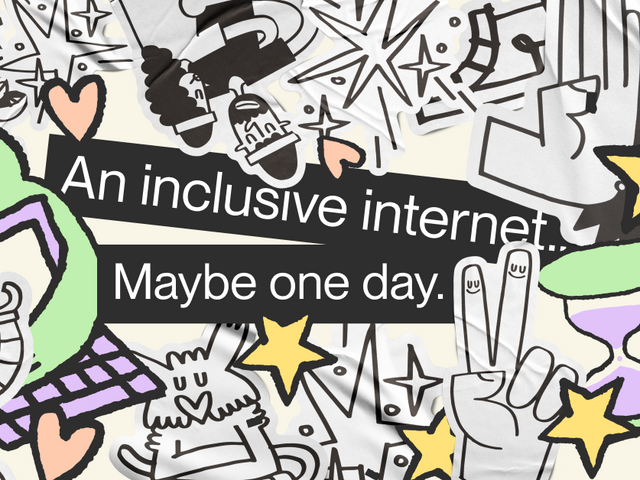Before we even start talking about whether or not the internet is an inclusive place, we need to talk about equal access to the internet. After all, the basic definition of inclusion according to my real-life Oxford English dictionary is: “the act of including someone or something.” So, whether or not everyone can actually access the internet is a pretty important detail. oxio was founded on the belief that everyone should have equal access to the internet and the opportunities that come with it. And yeah, that’s a loaded statement—especially considering what’s been going on with the internet in Canada. But let’s break it down.
First, we need to understand that not everyone has the same internet needs. We use it at different times, for different reasons and in different ways. And that means that the internet means something different to everyone—a way to stay in touch, travel, shop, learn, create, escape. For us, it’s a way to empower people—to connect everyone to the opportunities the internet provides in a secure, accessible and convenient way. Step one in accomplishing that is sharing the importance of equal access one story, post, meme, stream, game, wiki, email, connection (phew) at a time. Why? Well, we believe that if everyone had equal access to the opportunities found on the internet, we’d see a lot of pretty great things from a lot of unexpected people. And that potential is too awesome to ignore.
But let’s calm down for a second and get real. You know, establish what the current situation actually is here in Canada.
More Canadians have access to high-speed internet than we thought.
Since around 2014 the Government of Canada has been working towards what they call “Universal high-speed Internet access”. And they’re succeeding. In 2014 79% of Canadians had access to high-speed internet.1 But hold on, what’s the government's definition of high-speed internet? Well, it’s “broadband connectivity with a download speed of 50 Mbps and an upload speed of 10 Mbps”.2 How’d they come up with that number, you ask? Well, according to them, “An Internet download speed of 50 Mbps or more allows users to do online activities such as supporting multiple users at a time, streaming ultra-high-definition video with more than one connected device, or quickly downloading a high-definition movie.” And we agree with them—you can read all about how to figure out what internet speed you need on our blog. And no, having the fastest internet speeds in the universe doesn’t necessarily make your life online better.
Okay, where were we… 2014, 79%... Right, thanks in large part to the government’s 585 million dollar Connect to Innovate program, 84.1% of Canadians were connected to high-speed internet by 2017, 85.7% in 2018, 87.4% in 2019, 89.7% in 2020.3 And, as I’m sure you know, this is where things get all pandemic-y.
2020 aka COVID-19 aka the internet as a utility.
To give credit where credit is due, the government did announce Canada’s Connectivity Strategy in 2019. And then the COVID-19 pandemic reinforced and accelerated this strategy. Why? Well, suddenly a huge portion of the population was stuck at home. And what helped distract us, allow us to keep working, learning, living, connecting? The internet.

To sum up pretty much all the news from those early pandemic-filled days: life without the internet is becoming harder and harder to imagine. For us, that means that the internet should be a utility and not a service or contract. And we’re not the only ones who think that. In 2020 the government announced their 3.22 billion dollar Universal Broadband Fund. This fund brought the government’s investment in telecommunications infrastructure since 2015 up to 7.6 billion dollars.3 So, yeah, we can safely say the Government of Canada is serious about getting every Canadian connected to high-speed internet.
But, all these facts and numbers are kind of misleading. When we separate them into rural and urban, we can start to understand part of the reason why the final 10% is taking so long. The government has promised that 100% of Canadians will have access to high-speed internet by 2030. And when it comes to urban Canada, we’re basically already there. In 2020 99.2% of urban Canadians had access to high-speed internet. But, only 54.4% of rural Canadians had access.3 Yeah you read that right: 54.4%! And, if we take an even closer look, we realize that the communities that are lacking access to high-speed internet are the ones that need it most.
High-speed internet access in Indigenous communities: what the actual f is taking so long?
In Canada, just 24% of Indigenous communities have access to high-speed internet.8 This glaring inequality amplifies some already pretty drastic socio-economic differences, and, again, the COVID-19 pandemic amplified all of this.9
Without equal access to essential online services such as doctors, education, shopping, counselling, news media, social media, delivery services and COVID-19 vaccine registries, Indigenous communities just can’t access the plethora of services that continue to move online. Business opportunities, employment, education, and physical and mental health.8,9,10
To us, it’s become pretty clear that the internet is an essential service and should be treated as a utility. And we’re clearly not alone in our belief.
So, what’s the hold up?
Well, the big telcos have been claiming for years that it is not in their best interest to expand their high-speed infrastructure into the rural markets. (It’s not as profitable as they would like.) So, just like when the government helped the big telcos build Canada’s initial telecommunications infrastructure to ensure every Canadian had access to a phone line, the government’s now lending a pretty substantial hand by funding the expansion of our high-speed internet infrastructure.11
So, every Canadian will eventually have access to high-speed internet.
But what about equal access to the opportunities found online once we’re actually, you know, online? Well, that’s a bit more complicated.
The short-ish answer is: equal access online just doesn’t exist. The longer answer is: There are a lot of barriers to overcome before we achieve any kind of real equality online:12
- Around one third of the world still doesn’t have access to the internet.
- Even if you do have access, it might be limited by cost (either the cost of the internet or of a computer or mobile phone), shitty connections, know-how or censorship.
- The internet is mostly in English.
- Algorithms can be kind of—or even straight-up are—racist.
- Having a disability can make doing anything online pretty friggin hard.
Phew. Okay, so let’s chat about all this.
It’s easy to ignore, but one third of the world just isn’t online.
As of April 2022 there were 5.03 billion internet users—aka 63.1% of the world’s population.13 Yeah, that’s a lot of people online. But, that’s also a lot of people who aren’t online, and that’s hard to believe considering how necessary the internet is to our daily lives here in Canada. But, there’s some good news. There are now more people online in developing countries than in developed countries, and that means more voices and more diversity online.14
Bridging the remaining digital divide (the gap between those who have the internet and those who don’t) isn’t going to be easy. Like everything else, wealthier countries and people are more likely to be online. Canada has one of the highest rates of access in the world, whereas Indonesia and parts of Africa, Asia and India are among the lowest.14,15
None of this is all that surprising when we take the time to think about it. But, it’s worrisome. As the internet becomes increasingly necessary to live and participate in our modern world, it simultaneously becomes a human right—or in oxio’s words: a utility.16
Since 2020, better known as since the pandemic, everything that could be moved online, moved online. Jobs went remote. Schools went virtual. Family visits, doctor’s appointments, grocery shopping—our lives moved online. In other words, the internet became a need, not a want. Our transition to an online world was accelerated during the pandemic, and that isn’t good news for everyone.
Cost, know-how and censorship. Oh my.
Let’s get right to the point: the cost of the internet is a barrier to actually accessing the internet. This isn’t, or shouldn’t be, news. Of the around 3 billion people not online, only 450 million of them live in an area not covered by some kind of internet access. The reason the other 2.5 billion-ish people aren’t online? They lack the tools, know-how and money to actually connect to and use the internet.17
If you just connect somebody with infrastructure, it doesn't mean that you're going to have productive use of your internet connection. - Robert Opp, Chief Digital Office at the U.N. Development Program
There are only a few developing countries where internet costs less than 2% of the average monthly income.17 (This isn’t just a random number, it’s the United Nations’ target for affordable internet.) And, when it comes to wealthier countries, poorer people often struggle to afford high-speed connections.
But, cost isn’t the only thing keeping people from loving the internet. The elderly and disabled also have problems navigating it. This knowledge gap became glaringly obvious during the pandemic—especially in countries where booking vaccine shots needed to be done online.17
And I won’t even get into how being less savvy online can lead to other problems like, say, fake news, identity theft, fraud, phishing and just straight-up theft.
Most apps and sites are designed for the “digitally privileged” (a term I just learnt that refers to people who already know how to live online). The problem with that is that it excludes everyone else.17
The takeaway: when it comes to the internet, one size doesn’t fit all.
Wait. You forgot to talk about censorship and what do you mean one size doesn’t fit all?
We’ll come back to the “one size doesn’t fit all” thing in a bit. As for censorship, well:
According to AccessNow and the #KeepItOn coalition, there were 182 internet shutdowns across 34 countries in 2021.18 And that seems to be the norm these days: in 2020 there were 159 in 29 countries and in 2019 there were 213 in 33 countries. These shutdowns, blocked platforms and throttling, were triggered by protests, social or political unrest, elections, active conflicts and even student exams.
Algeria, Chad, Cuba, Myanmar, Pakistan, the Republic of the Congo, India, Iran, Niger, Syria, Uganda, Yemen. The list goes on and, unfortunately, isn't all that surprising. We could write a whole article on internet censorship around the world, and probably another one on China and another one on Russia. (Good idea, David, get on it.) But for now, we’ll just say that internet censorship is a dangerous thing. It undermines democracy, hurts human rights and can have pretty bad economic effects.18
But, thanks in large part to the internet, the world is watching and reacting. The G7 countries condemned the practice of disrupting or limiting a population’s access to the information, knowledge, and data online.18 Court challenges are underway. But but but, as we continue to rely on the internet in almost every aspect of our lives, censoring it is going to cause more and more harm and do a lot of damage when it comes to human rights.
A side note about throttling here in Canada.
Yes, throttling in Canada does happen. But what is throttling? Well, it’s when a telecommunications company limits the speeds of its customers' internet access.
In Canada, the law forbids unfair discrimination and undue or unreasonable preferences, and requires that regulation be technologically and competitively neutral. In simpler words, it’s illegal for a company to throttle your internet speeds if it is targeted to specific sites, locations, individuals, etc., but very legal if it is applied to the whole internet.19
Even here in Canada, the internet isn’t quite as inclusive as we think.
The internet is just not a welcoming place for a lot of people.
Okay, after that super light and uplifting section, let’s dive right into the harsh reality of the internet. Aka, even if you do have access to the internet—and can afford it and your government or leader doesn’t censor it and you actually want to use it—you might not be able to because, for now, it’s a one size fits all kind of place. (Told you we’d come back to it.)
First up, let’s define inclusion. Way back at the beginning of this article we used my trusty old Oxford dictionary to define inclusion as: “the act of including someone or something.” But, we thought we’d share another definition from our beloved internet: “the practice or policy of providing equal access to opportunities and resources for people who might otherwise be excluded or marginalized, such as those who have physical or mental disabilities and members of other minority groups.” Phew. We think that’s a bit more complete, so we’re going to work with the internet’s definition.
All in all, only around 2% of websites are accessible to people with disabilities.20 2%!? That’s basically nothing. And yeah sure we can argue that of the 1.98 billion websites on the internet, not all of them are worth visiting—like, according to my coworker Shion, cat-bounce.com. (But I think cat-bounce.com is pretty legit.) But if we break it down a little further, it turns out that 97.4% of the world's top one million websites aren’t fully accessible.21 In other words, most websites just aren’t inclusive places and the reason is pretty simple: the internet just wasn’t built with accessibility in mind.
And, you guessed it, as more and more of our life happens online, this lack of accessibility is becoming a pretty glaring problem. People with disabilities should be able to access the services, products and information the internet has to offer. Especially if we consider the internet as a public space. Which we do.22
Now, let’s be clear, we’re not doing nothing. Even though online accessibility stats have only barely improved over the past few years, companies are slowly beginning to make their websites accessible. (The number of new websites every year and the increased complexity of those sites pretty much negates the accessibility work existing sites are doing.)23 Legislation like the Accessible Canada Act is being … legislated. Committees like the Technical committee on accessibility requirements for Information and Communication Technology Products and Services are being formed. But, change is surprisingly slow for an industry that does nothing but change.
We forgot to talk about racist algorithms.
This one’s a doozy and definitely needs its own article. So for now, we’ll just say that algorithms are everywhere. They make a lot of really important decisions about our lives for us—they decide which political ads we see, they screen our applications to, well, everything, they calculate risk when we buy insurance, they choose which movies you like. The list is endless and getting longer. And the algorithms doing all the deciding are often biased and pretty secretive. We know the end result (how it affects us), but we don’t really know how the algorithm ended up at that result.24
Did it include your past online visits? Did it discriminate because of your age, skin colour, sex, background? Did it assume you were something you’re not? Did it take your beliefs into account? The answer is more often than not: yes, it probably did.25 And the solutions just aren’t keeping up with the times.
Algorithmic racism not only replicates, but also exacerbates economic, social, and racial injustice.25 - Jane Chung, Public Citizen.
Okay, we promise we’ll write a whole article on this. But just know, the algorithms that run the internet and determine more and more details of your life are most likely biased. And the reason why is pretty fascinating. Unless they’re designed to account for the history of and ongoing discrimination, inequality, and bias, algorithms will just keep replicating racial inequalities. And, in most cases, even make it worse. And doing something about it is really hard. Algorithms are less transparent, less accessible, and difficult for you and me to understand—which make them hard to regulate and audit.25 In other words, when it comes to algorithms:
There is no way to look inside and see how the sausage is made.25 - Jane Chung, Public Citizen.
It’s easy to ignore it all.
How often have you been exploring the world wide web and thought “Huh. This would be really hard for a blind person to navigate”. Probably never. And in all fairness, oxio’s own site isn’t leading by example. Neither is our blog. But step one is recognizing a problem. Thinking of others. Being empathetic. Having morals and sticking to them. Step two is actually doing something about it. And we are. We’re fighting for equal access. We’re transparent about how and why we do what we do. Our pricing is fair and sustainable. We’re redesigning our internet plan builder and checkout process to:
- Provide a clear and predictable flow.
- Guide and support you with meaningful copy.
- Improving the colour contrast.
- Have adjustable font size.
- Label all our input fields.
- Give informal guidance when errors occur.
- Use straightforward language, none of that technical blah blah blah.
- Be more responsive across desktop and mobile.
It’s not perfect. But it’s a start. And like everything we do, we’ll keep getting better.
So, is the internet an inclusive place? No. No, it is not. But there are guidelines and tools out there to help. There’s the Web Accessibility Initiative that has “a goal of providing a single shared standard for web content accessibility that meets the needs of individuals, organizations, and governments internationally.”26 And Google does a bang-up job of walking us through how they design for accessibility.27 Hint, hint: awareness is the first step.
A big big big thank you to Danilo for his feedback and English to français adapting skills. And, an equally big shout out to Hugh, one of oxio’s two super talented UX/UI designers. Oh, and another equally big thanks to Nycolas and Shion for their helpful comments. And last, but not least, the internet—without it, this article just wouldn’t be possible.
- High-speed internet for all Canadians
- Access to the Internet in Canada, 2020
- Progress toward universal access to high-speed Internet
- Bridge the Digital Divide for Indigenous Communities
- Indigenous communities must have internet access on their terms
- Broadband Internet in Indigenous Communities
- A fable about the internet in Canada.
- Internet usage has risen sharply amid coronavirus pandemic, providers say
- We're watching so many videos that internet traffic is at unprecedented highs
- Online shopping has doubled during the pandemic, Statistics Canada says
- How a home internet connection is helping Canadians get through the COVID-19 pandemic
- Who is welcome online?
- Number of internet and social media users worldwide as of July 2022
- Smartphone ownership and internet usage continues to climb in emerging economies
- List of countries by number of Internet users
- How Internet Access As A Human Right Could Impact Tech Companies
- Costs, Literacy and Design: The Invisible Barriers to Tackling the Digital Divide
- Internet shutdowns in 2021: the return of digital authoritarianism
- Bell's internet throttling illegal, Google says
- Web Accessibility Is About Enabling Everyone To Take Part In Global Inclusion Efforts
- 53 Web Accessibility Statistics
- Is the Internet considered a public space with the rights to freedom of opinion and expression still applicable?
- The 2022 report on the accessibility of the top 1,000,000 home pages
- Why algorithms can be racist and sexist
- Report: Algorithms Are Worsening Racism, Bias, Discrimination
- WCAG 2 Overview
- Designing for Global Accessibility








